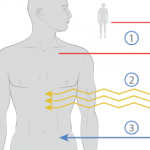

Life, Love, and Death
Palliative care in rheumatology is not an oxymoron or concession of failure. I thought about this subject after a recent rheumatology conference. The topic was “new therapies for systemic sclerosis.” One of our fellows presented a nice distillation of some of the new studies. The therapeutic targets (endothelin, phosphodiesterase, platelets, combinations of these, platelet-derived growth factor, and vascular endothelial growth factor) reflected evolving thinking about the important events in the pathogenesis of disease and available interventions. Unfortunately, none of these therapies worked consistently or impressively well. That seems to be the story of putative treatments for systemic sclerosis when ultimately investigated in rigorously controlled trials. The subsequent discussion at our conference focused on the role of these new therapies in managing systemic sclerosis patients. I mostly listened, because it’s been a while since I’ve actively cared for sick scleroderma patients.
Afterwards, I wondered about our discussion and the role of palliative care in scleroderma specifically and rheumatic diseases generally. Certainly, it is our imperative to help our patients, especially when their time is running out. Is it really evidence-based, compassionate practice to consider the standard to be recommending one or a combination of these essentially unproven treatments for progressive systemic sclerosis, despite the scant evidence for efficacy and the costs for some biologicals approaching $100,000 per year? Is that a rational and fair use of scarce resources? When our patients continue to progress to “end” stages and we have little of proven value to suggest, is that not when to consider instituting palliative care? Shouldn’t this at least come up in some fashion in our conversation? Do we do this as well in rheumatology?
In my former life as a department chair and in my recent personal life experiencing the slow, painful demises of my parents, I came to learn how valuable palliative care is when done well. It is underused and underappreciated. It is certainly not a concession of failure. Death is always 100%. Palliative care reflects the realities of a situation and seeks to provide the most possible comfort and best quality of life possible under the circumstances as long as possible. Who should understand this better than rheumatologists? We are committed to our patients and indeed, in that sense, we “love” our patients (refer please to my title, a poor attempt to emend that of the great Woody Allen spoof, “Love and Death”). Why have rheumatologists not been more visible in leadership roles in palliative care?1 We should indeed be more familiar, more active, more proactive, and more involved in this. It’s good medicine, and it’s good for our patients (at the appropriate time).
Requiescat in Pace, Doxycycline
I had grown sort of fond of doxycycline. I recall the studies of Bob Pinals and colleagues, published when I was finishing my fellowship, showing tetracyline’s inefficacy in rheumatoid arthritis (RA).2 Then Jim O’Dell and collaborators (and others investigators) documented that tetracyclines were effective in and had a role in RA.3 Ken Brandt and associates noted that tetracyclines protected against experimental osteoarthritis (OA) in animals (poor dogs).4
So, I hoped that the tetracyclines, presumably as metallo-proteinase inhibitors here, would turn out to have some value in treating patients with OA as well. They don’t.5 At least in this study, under these circumstances, for 24 weeks, twice-daily doxycycline was no better than placebo at relieving symptoms of OA. Adverse effects were considered to offer an unfavorable risk–benefit ratio. Disappointing. It’s hard to contemplate trying higher doses or longer duration of treatment, but maybe they could be used earlier in disease, maybe preventively or prophylactically, insofar as possible, or maybe another metallo-proteinase inhibitor will work.
May You Have a Long Life and Prosper, Progranulin
Progranulin (PGRN), an autocrine growth factor with cytokine-like properties, binds to tumor necrosis factor (TNF) receptors and moderates the action of TNF- in experimental arthritis. It thus has promising therapeutic potential. These elegant experiments found that PGRN bound directly to TNF- receptors, it antagonized TNF- actions, PGRN deficient mice had more severe collagen-induced arthritis than controls, recombinant PGRN reversed disease, and a protein containing 3 PGRN fragment, Atsttrin, was antiarthritic in mouse models and blocked TNF--related intracellular signaling.6,7 The authors’ cautious final statement was “the identification of PGRN and the PGRN-derived protein, ATSTTRIN, as antagonists of TNFR may lead to innovative therapeutics for various pathologies and conditions, such as rheumatoid arthritis.” That would be nice indeed.
Dr. Panush is professor of medicine, Division of Rheumatology, at the Keck School of Medicine, University of Southern California, in Los Angeles.
References
- Crosby V, Wilcock A. End-of-life care in rheumatology. Rheumatol. 2011;50:1187-1188.
- Skinner M, Cathcart ES, Mills JA, Pinals RS. Tetracycline in the treatment of rheumatoid arthritis. A double-blind controlled study. Arthritis Rheum. 1971;14: 727-732.
- O’Dell JR, Haire CE, P almer W, et al. Treatment of early rheumatoid arthritis with minocycline or placebo. Results of a randomized, double-blind, placebo-controlled trial. Arthritis Rheum. 1997;40: 842-848.
- Yu LP Jr, Smith GN Jr, Brandt KD, et al. Reduction of the severity of canine osteoarthritis by prophylactic treatment with oral doxycycline. Arthritis Rheum. 1992;35:1150–1159.
- Snijders GF, van den Ende CHM, van Riel PLCM, et al. The effects of doxycycline on reducing symptoms in knee osteoarthritis: Results from a triple-blinded randomized controlled trial. Ann Rheum Dis. 2011;70: 1191-1196.
- Tang W, Lu Y, Tian GY, et al. The growth factor progranulin binds to TNF receptors and is therapeutic against inflammatory arthritis in mice. Science. 2011;332: 478-484.
- Wu H, Siegel RM. Progranulin resolves inflammation. Science. 2011; 332:427-428.


